When Patrick Vieira was dismissed as manager in March, Crystal Palace found themselves just three points clear of the relegation zone after 27 matches of the Premier League season. A 4-1 defeat to Arsenal at the Emirates Stadium followed, overseen by then Under-21s head coach Paddy McCarthy. Roy Hodgson was then re-appointed as manager until the end of the season.
Fast forward six matches and Hodgson helped Palace pick up a further 13 points, scoring 13 goals and conceding seven in the process. This moved them onto 40 points for the season. A defeat away to Tottenham Hotspur came before a home victory over Bournemouth and an away draw to Fulham, guaranteeing another season of Premier League football at Selhurst Park.
In fact, Palace only picked up 14 points in the 17 matches before Hodgson’s arrival. The turnaround has been remarkable, but how exactly has Hodgson helped to achieve this?
This tactical analysis piece will aim to answer that question by looking at the tactics that Hodgson has implemented as well as an analysis of how these tactics have worked.
Formation and preferred line-up
Hodgson tends to set Palace up in a 4-2-3-1 formation. Sam Johnstone has played the last eight matches in goal. He is usually behind a back four of Joel Ward, Joachim Andersen, Marc Guéhi, and Tyrick Mitchell. Midfielders Cheick Doucouré and Jeffrey Schlupp have partnered each other in the middle of the pitch in six of Hodgson’s nine matches in charge.
Further forwards, Michael Olise and Eberechi Eze have started all of Hodgson’s matches, with Olise operating on the right side and Eze playing as the attacking midfielder. Wilfried Zaha usually plays on the left side, with either Jordan Ayew or Odsonne Édouard being used as the lone striker. When Zaha isn’t selected, Ayew normally takes his place on the left with Édouard continuing up front.
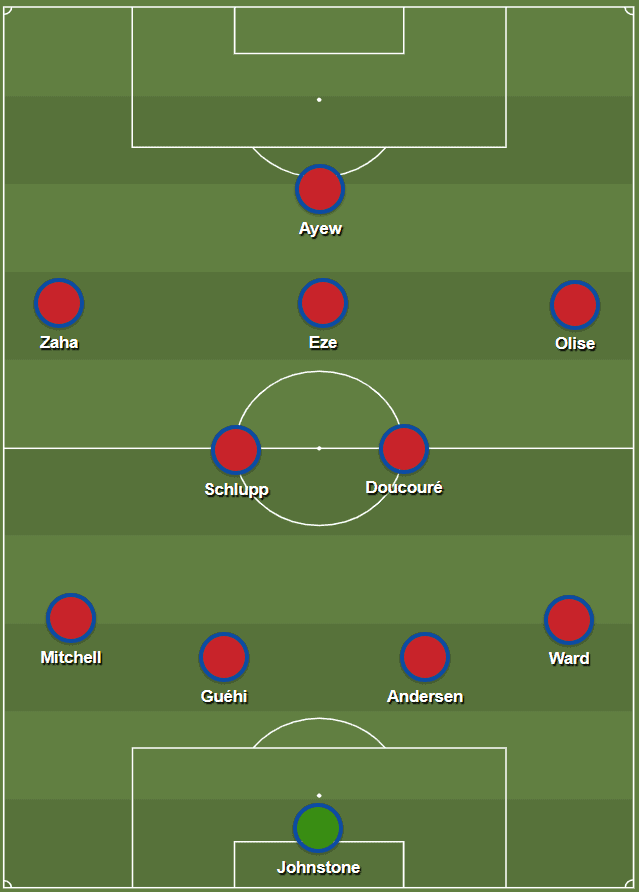
Palace’s attack
Before we go any further, we have to mention the sample size. Hodgson has only taken charge of nine matches since his return. It’s therefore too early to suggest that all of Palace’s problems have been solved after a good run of results.
Palace have also had a favourable run of fixtures, playing the likes of Leicester City, Leeds United, Southampton, and Everton recently. However, this is the only data we have at this point, and we’re still able to gain some interesting insights when we look into the numbers a bit further.
Before Hodgson’s arrival, Palace scored 0.79 goals per 90 minutes, against an expected figure of 1.02. In the nine matches Hodgson has taken charge of so far, Palace have scored 1.89 goals per 90 minutes. This is compared to an expected figure of 1.47.
This tells us a couple of things.
Palace have scored and have been expected to score more goals per 90 minutes under Hodgson than before his return. Also, before Hodgson’s return, Palace were underperforming in front of goal. But since he has taken charge they are scoring more than expected.
Palace are also shooting more often per 90 minutes under Hodgson (13.22 shots taken compared to 9.21 before his return), and are taking more touches in the opposition penalty area (23.11 per 90 minutes compared to 14.25 previously). They’re also attempting more crosses (14.00 per 90 minutes compared to 10.61 previously), and on average have more possession (53.83% with Hodgson compared to 43.57% before his arrival).
One of the reasons for this stark improvement in front of goal is down to the reintroduction of Eze to Palace’s starting eleven. As earlier mentioned, Palace typically line up in a 4-2-3-1 formation with Eze playing as the attacking midfielder. He has more of a free role when Palace are in possession. This means that he can drift out to either side of the pitch to assist the wide players. Eze can also make forward runs through the middle, knowing two midfield teammates behind him can help to mitigate the risk of opposition turnovers.
Eze has started all nine of Hodgson’s matches this season, scoring six goals in the process. He had started only two of the previous 10 Premier League matches before Hodgson’s arrival. Eze also hadn’t played a full 90 minutes since November.
The below pizza chart compares Eze to other attacking midfielders in the 2022/23 Premier League season. We can see that Eze ranks well at metrics like goal contributions per 90 minutes, expected goal contributions per 90 minutes, and shots per 90 minutes.
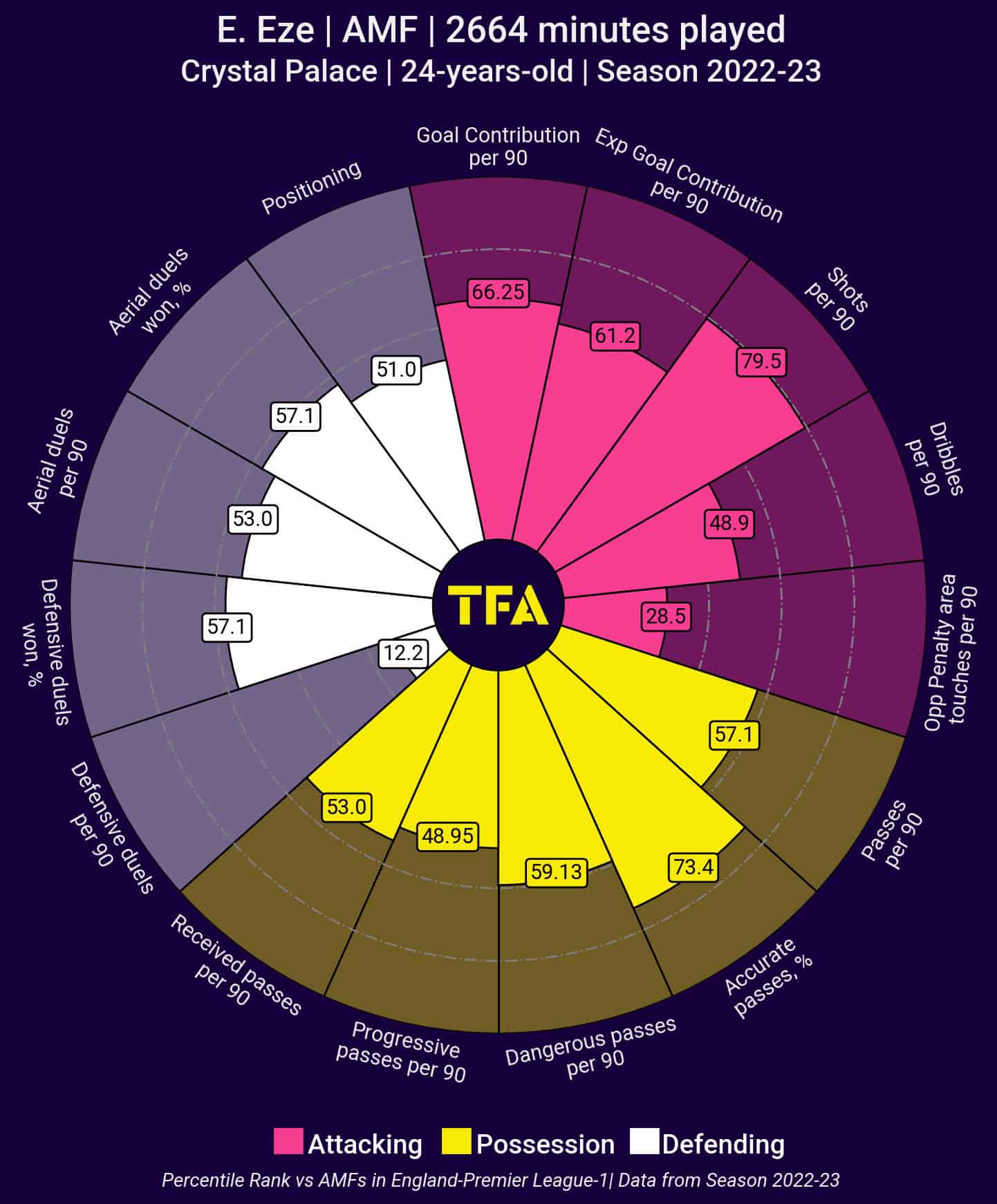
Eze’s inclusion allows Palace to get four exciting attacking players onto the pitch at the same time. More often than not these have been Eze, Olise, Ayew, and Zaha. Their awareness of each other’s positioning and ability to find space helps to cause chaos for the opposition.
Below is a screenshot from a recent home match against West Ham United. We can see Olise pass the ball toward Doucouré. Eze moves towards the ball by dropping deeper, taking West Ham’s Declan Rice with him. This creates space for Olise to run into in the process.
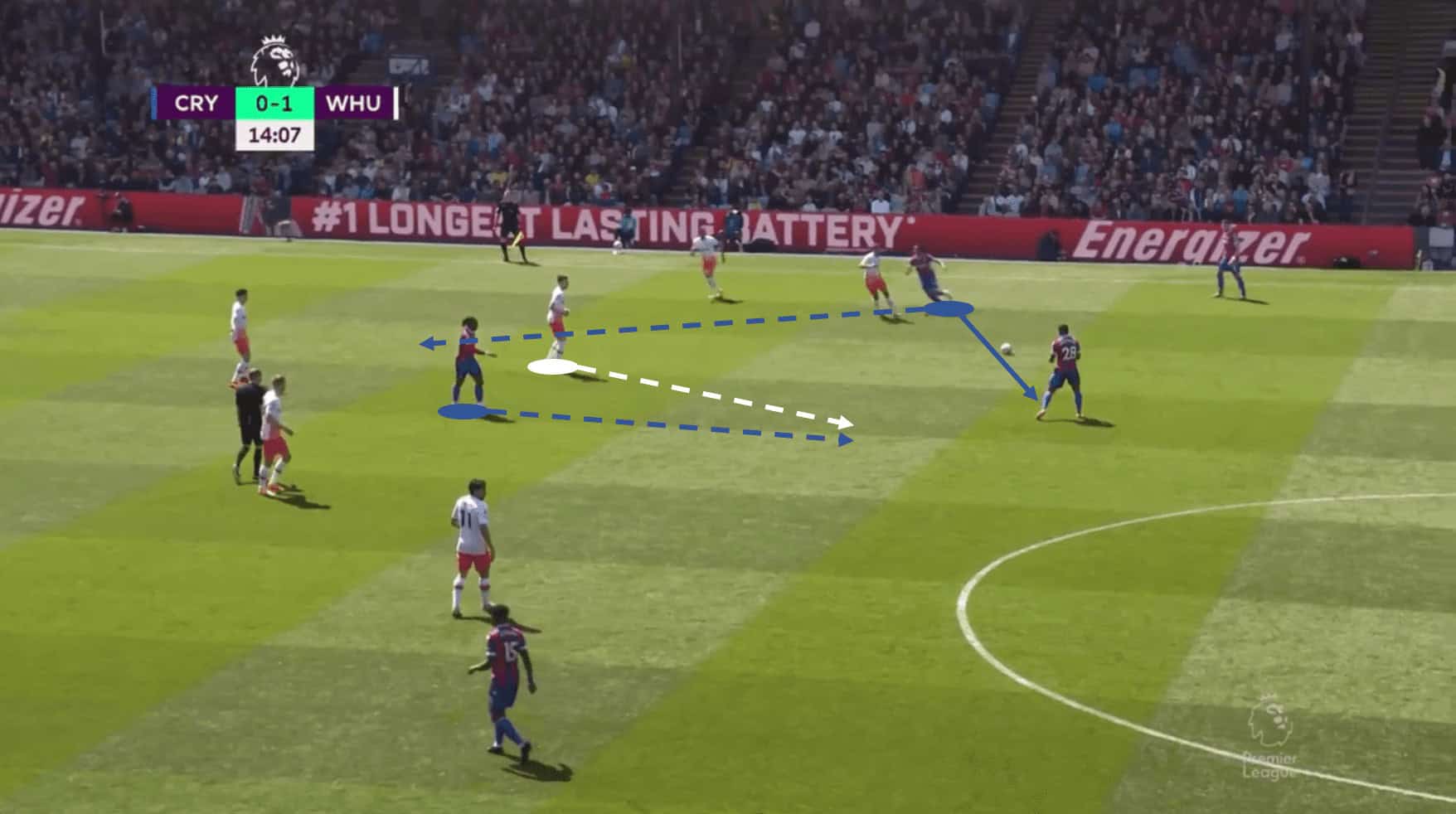
As we can see below, Olise is then able to receive the ball in space between five West Ham players. He manages to play a through pass to Ayew who has made a forward run beyond West Ham’s defensive line. Ayew collects the pass and scores for Palace.
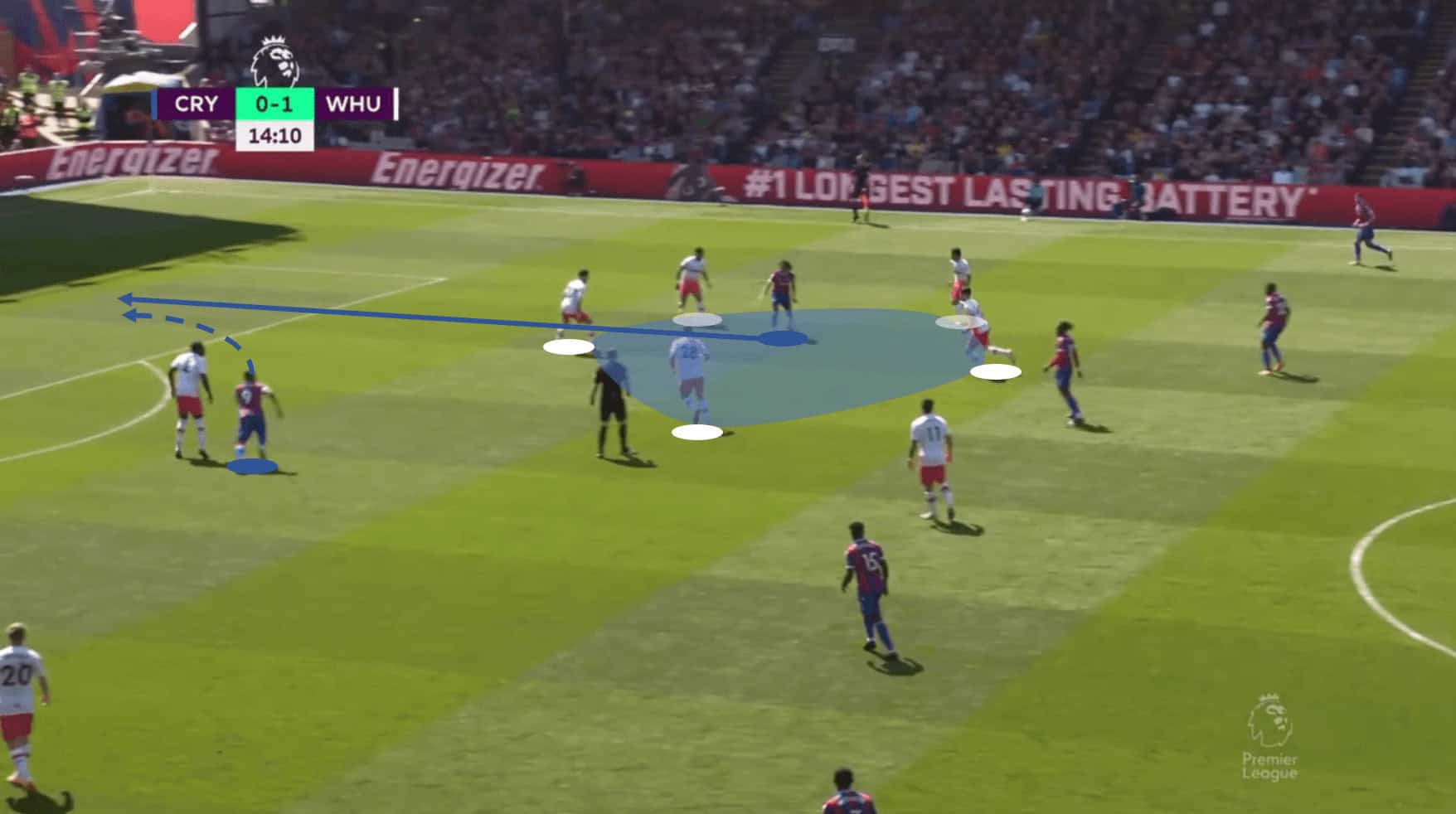
Below is another screenshot, this time from Palace’s match away to Leeds United. Eze was able to find space between four opposition players in which to receive a pass. He then had time and space to turn and pass out to Palace’s right side where Olise was waiting. Once he released the ball, Eze then made a forward run up the pitch.
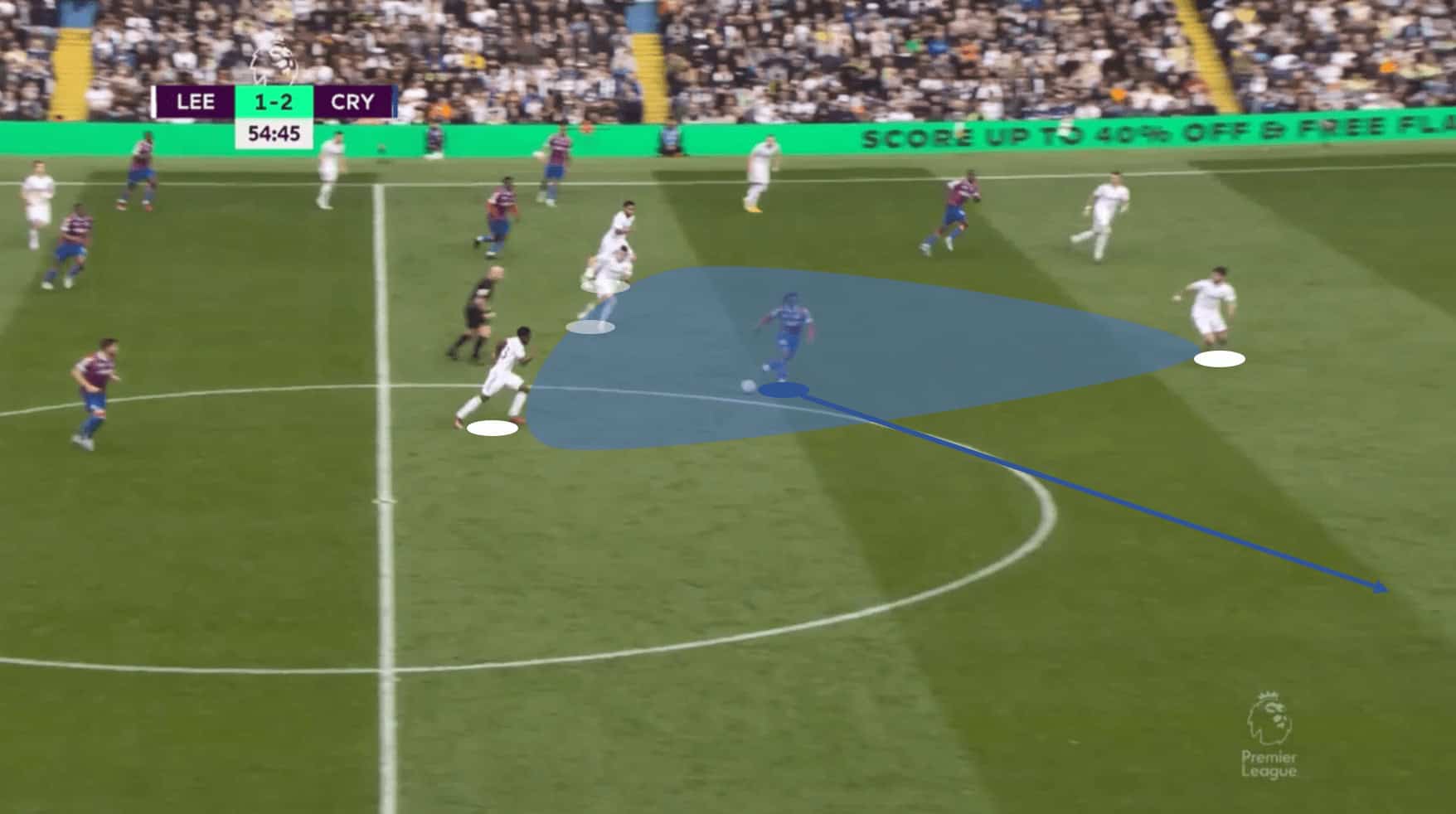
Below, we can see how once Olise had controlled the pass, he held the ball up to wait for Eze. Eze then made a run beyond Leeds’ defence into space. Olise then played a nice pass between two Leeds players for Eze to run onto, who scored past Illan Meslier.
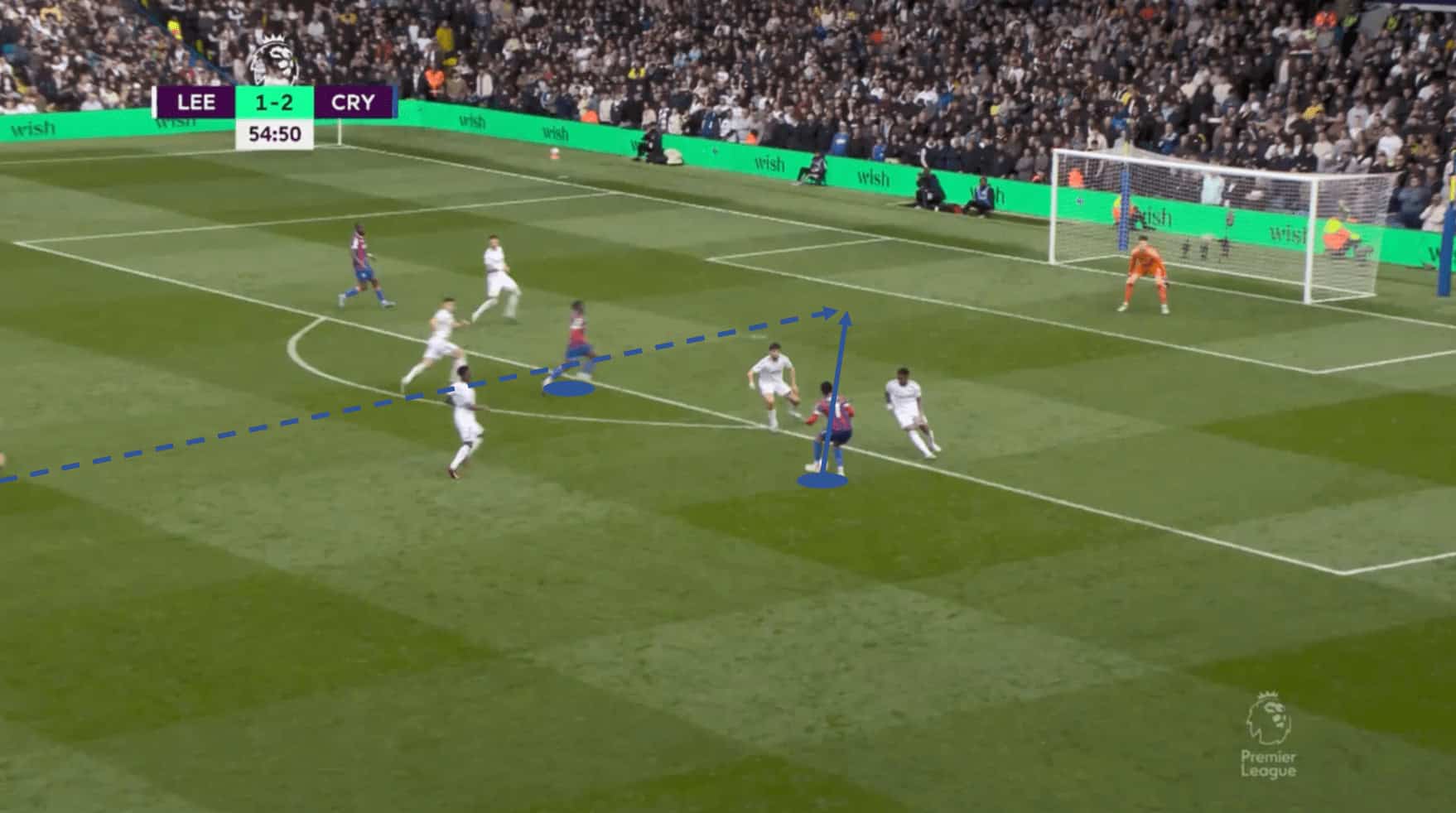
Palace’s directness
Palace are also playing more long passes since Hodgson has returned (47.33 per 90 minutes under Hodgson compared to 43.96 previously), and attempting more aerial duels (46.89 per 90 minutes compared to 32.71 per 90).
In this example against West Ham United, Palace centre-back Andersen played a long pass toward Olise, who challenged for an aerial duel. The loose ball fell to Eze, who had got himself ahead of the West Ham midfield. This meant that he was therefore able to pounce on the loose ball first.
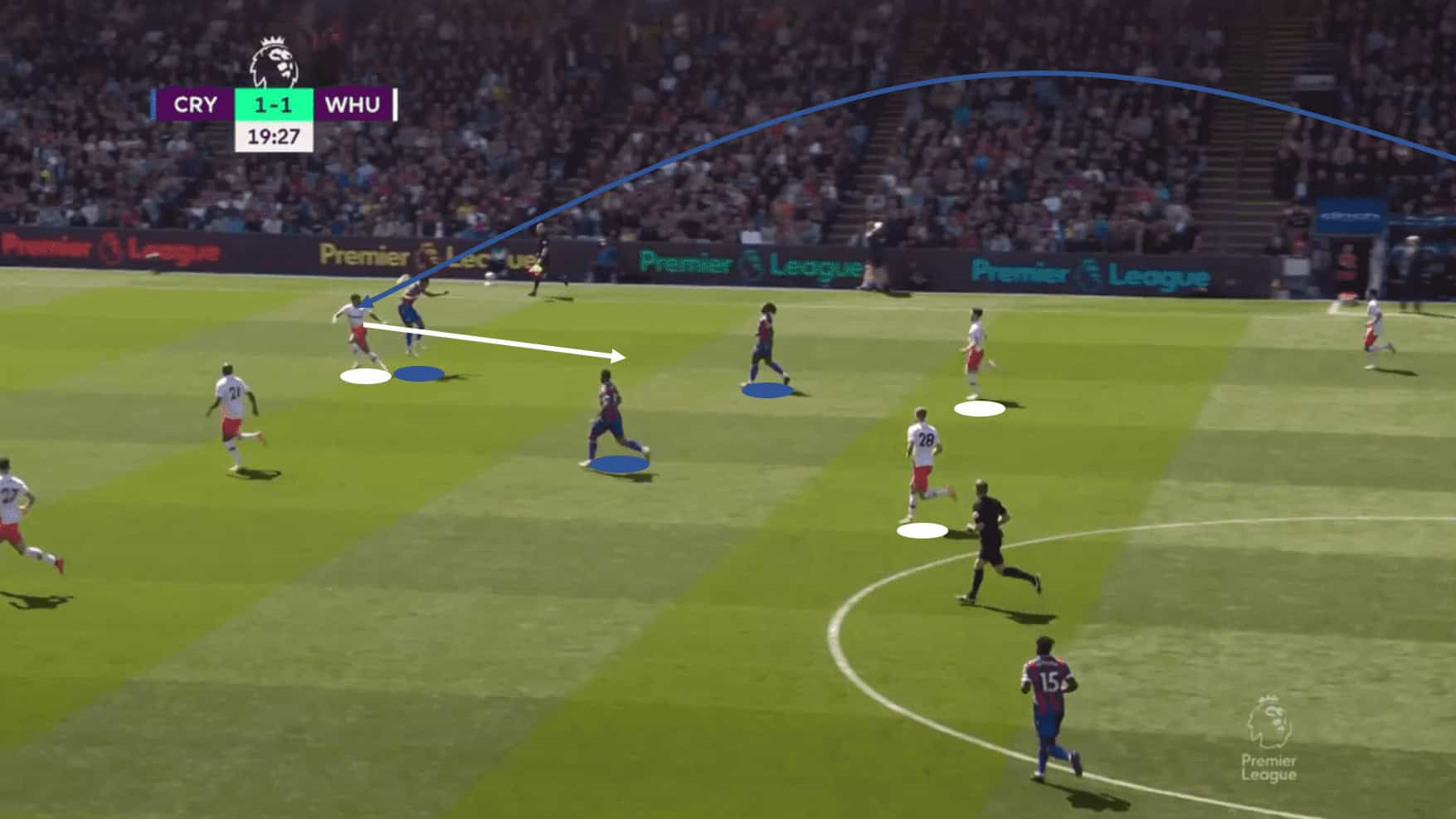
Palace then found themselves with numerical superiority, as we can see below. West Ham left-back Emerson was outnumbered three to one. Upon collecting the loose ball, Eze was then able to pass to Ayew, who was easily able to find space. Ayew passed forwards to Olise, creating a goalscoring opportunity for Palace. Olise’s cross eventually fell to Zaha at the back post, who scored.
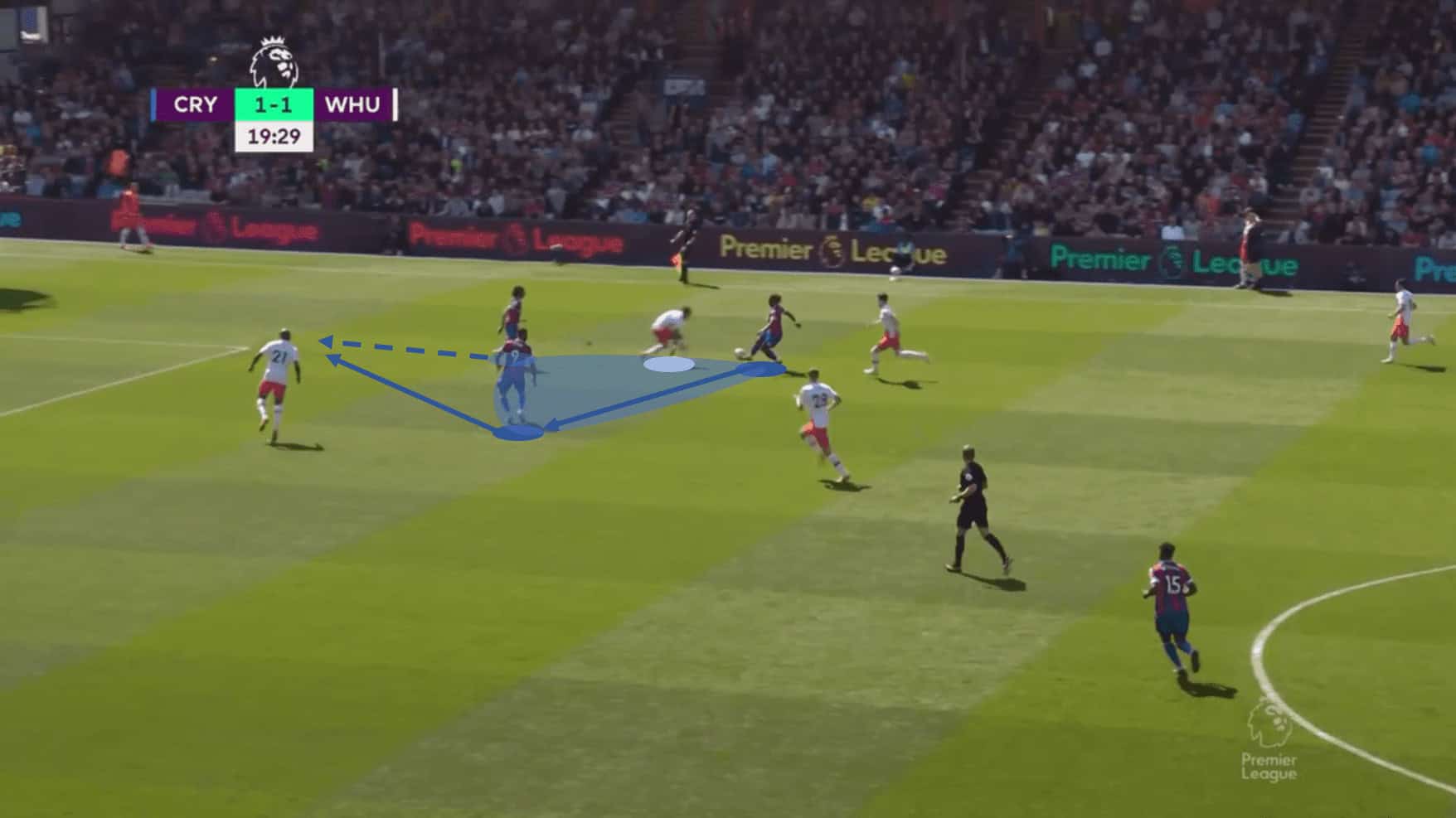
Out of possession
So, what about out of possession? Perhaps surprisingly, Palace seem to have employed more of a high press since Hodgson’s arrival. They now allow the opposition 10.01 passes on average before they make a defensive action, compared to 13.66 passes previously. Palace are also forcing the opposition into playing more long passes since Hodgson’s return. Their opponents on average play 49.22 long passes per 90 minutes under Hodgson compared to 45.18 previously. This reinforces the idea that Palace’s high press is more effective now.
Against West Ham United, this high press worked to perfection in the first half. With West Ham in possession on their right side, Palace had shifted to their left and employed a man-to-man press. From the below image, you can see how there is one West Ham player in space on their left side. However, everyone else has a Palace player nearby, illustrating how Palace shifted towards the ball side. This helped them to help maximise the effectiveness of their man-orientated press.
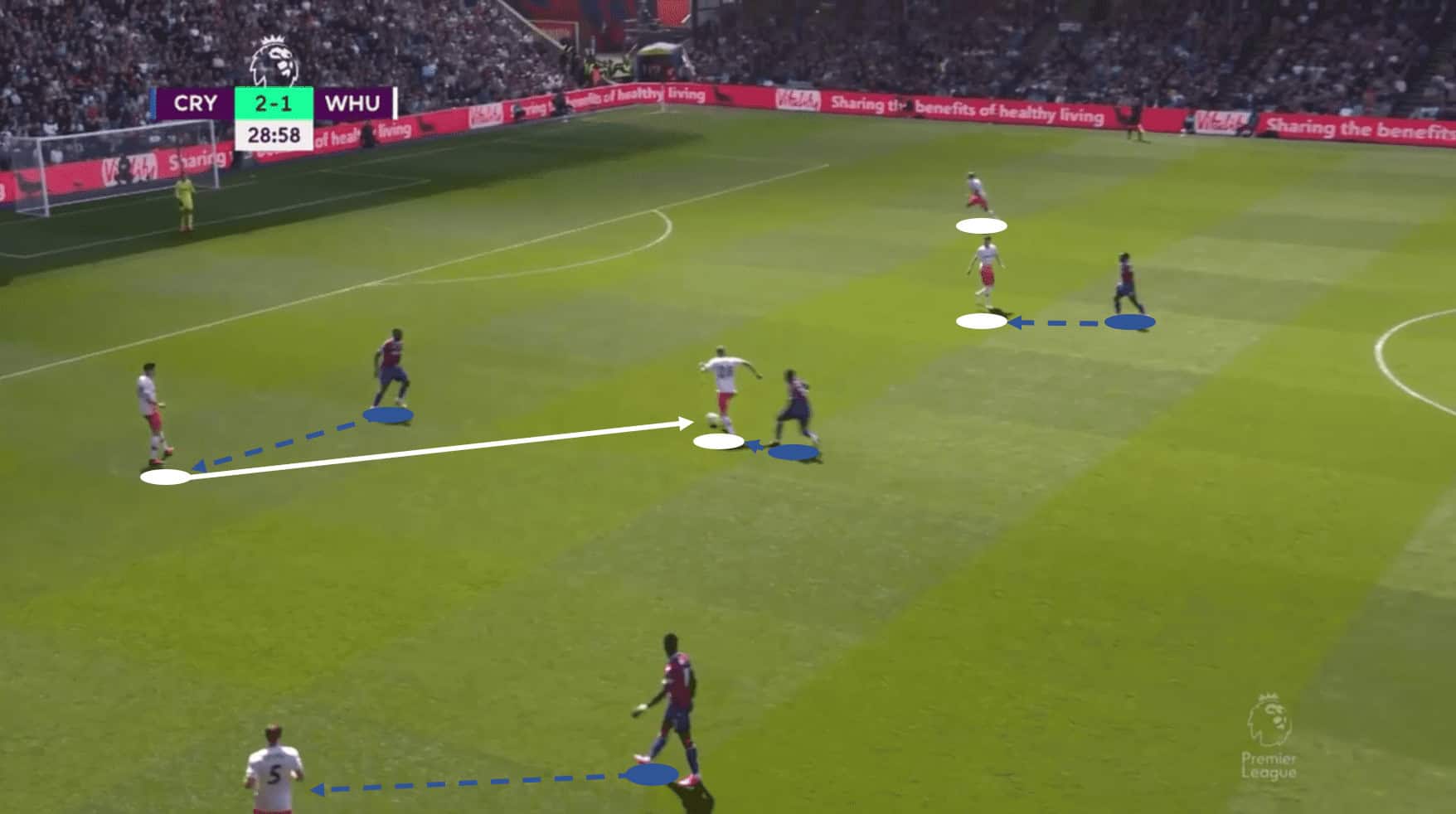
In this example, West Ham’s Tomáš Souček received a pass but had Palace’s left-sided central midfielder Schlupp close by. Schlupp capitalised on a heavy touch by Souček, dispossessing him before running towards the goal and scoring (below).
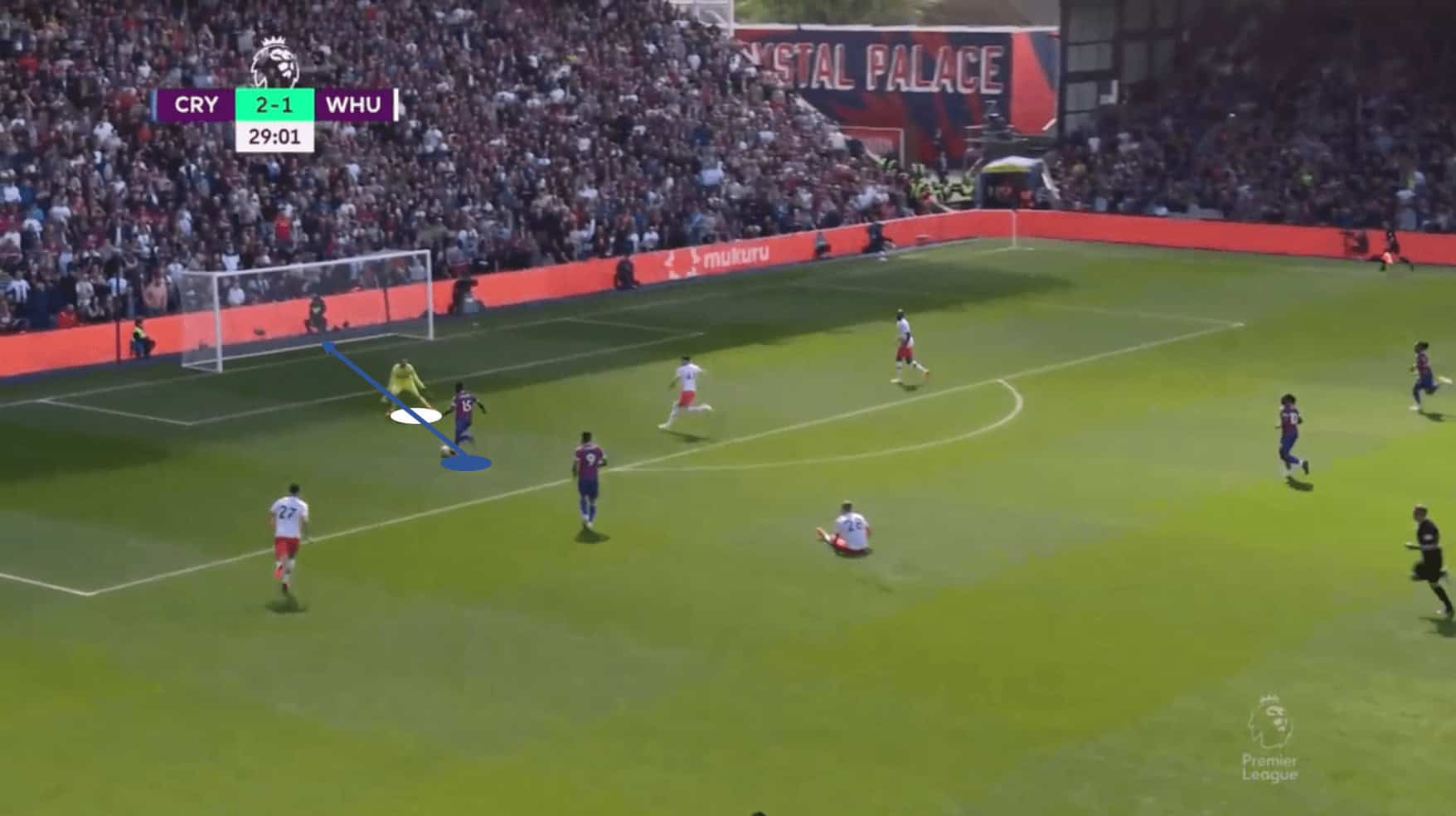
If the opposition manages to beat this press Palace can sit back into a 4-5-1 defensive block. This has two main benefits. Firstly, it allows compactness in the centre of the pitch by having three midfield players who can stay central. These midfielders know the wingers on either side are covering the wide spaces. Secondly, it allows Palace to have two wide players on either side. This helps to potentially double up on opposition wingers to reduce the risk from out wide.
This second point can be further contextualised. Since Hodgson has returned to Palace, the opposition have only attempted on average 10.67 crosses per 90 minutes compared to 17.32 previously. To help with this, Palace require their wingers to drop deeper, buying into Hodgson’s game plan to help their team. This is a very basic example of the togetherness that an experienced coach like Hodgson has instilled in Palace. This mustn’t be underestimated.
From the below image, we can see Palace’s 4-5-1 defensive block from a recent match away to Southampton. Notice how Olise and Ayew (who was the left winger) have dropped deeper to form the midfield five. We can also see how, even when Palace apply pressure to the ball carrier, there are still two other central midfielders occupying the middle of the pitch to eliminate passing options.
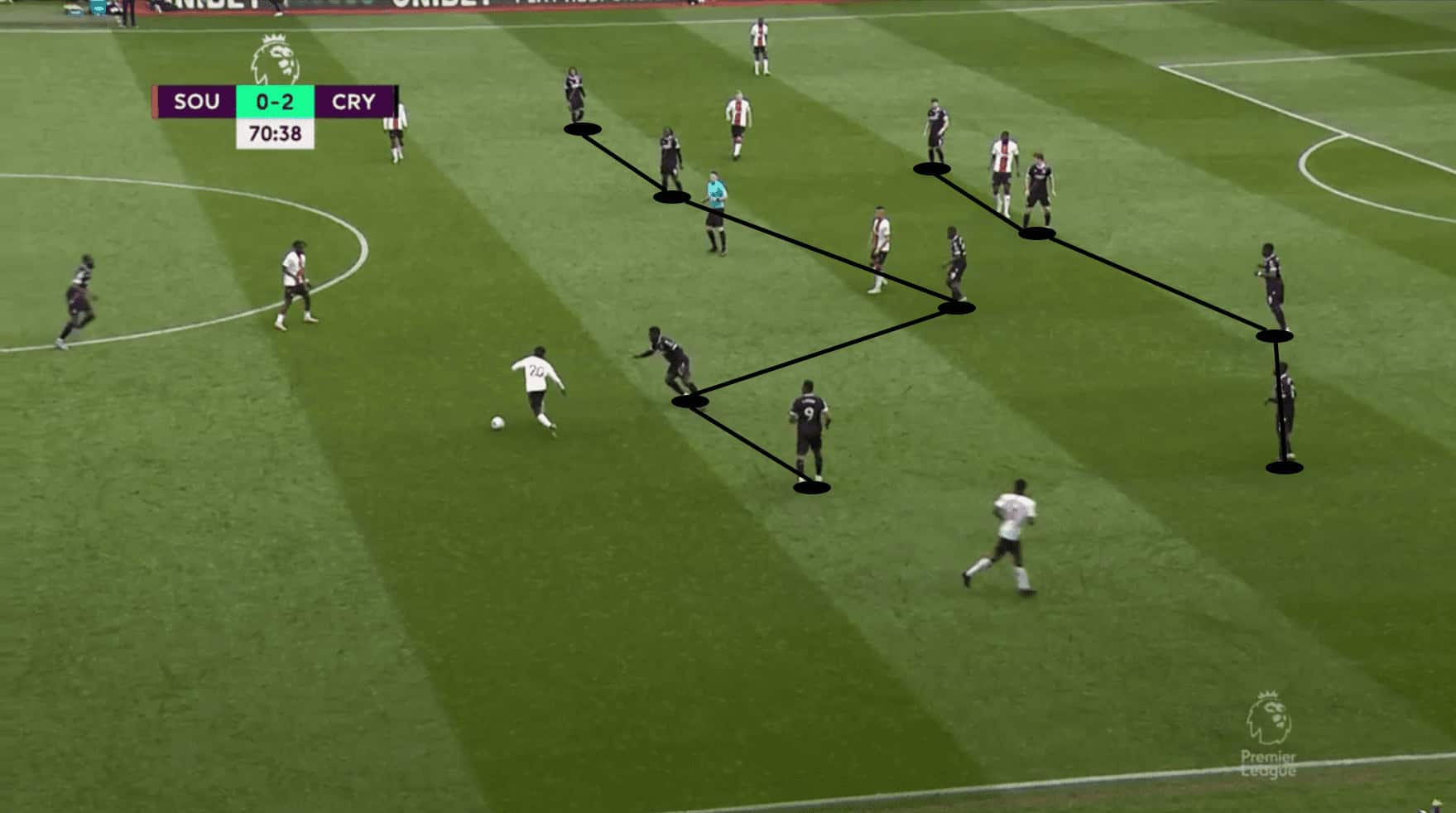
This defensive structure has helped Palace concede fewer goals on average than before Hodgson returned to the club. They have now conceded 1.11 goals per 90 minutes compared to 1.36 before Hodgson’s return. They have also allowed fewer expected goals (0.87 per 90 minutes with Hodgson compared to 1.47 previously. Palace have also conceded fewer shots per 90 minutes with Hodgson than previously (8.11 per 90 minutes compared to 12.07).
This newfound defensive solidity, as well as the pace that they have in attack and the reintroduction of Eze to the side, has allowed Palace to also possess a real threat on the counter.
In this example against Leeds United at Elland Road, you can see Palace breaking away with their front four. They managed to get themselves ahead of a couple of opposition players, giving them a numerical superiority of four versus the remaining two Leeds defenders.
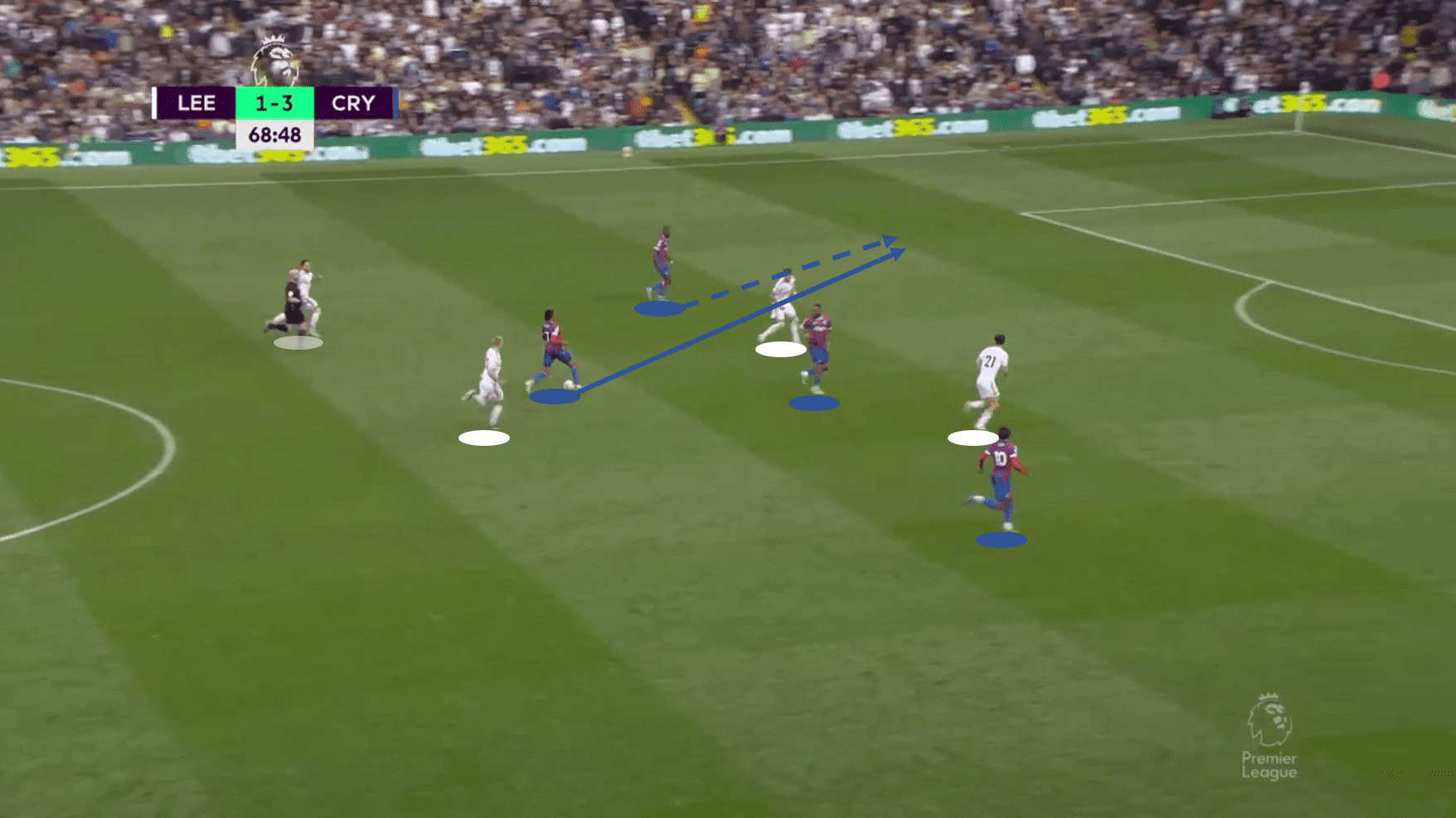
As we can see above, Olise had the ball and was driving towards Leeds’ goal. He managed to invite pressure from a Leeds defender, which created space for Édouard. Olise then played a through pass toward Édouard, who continued moving forwards before scoring.
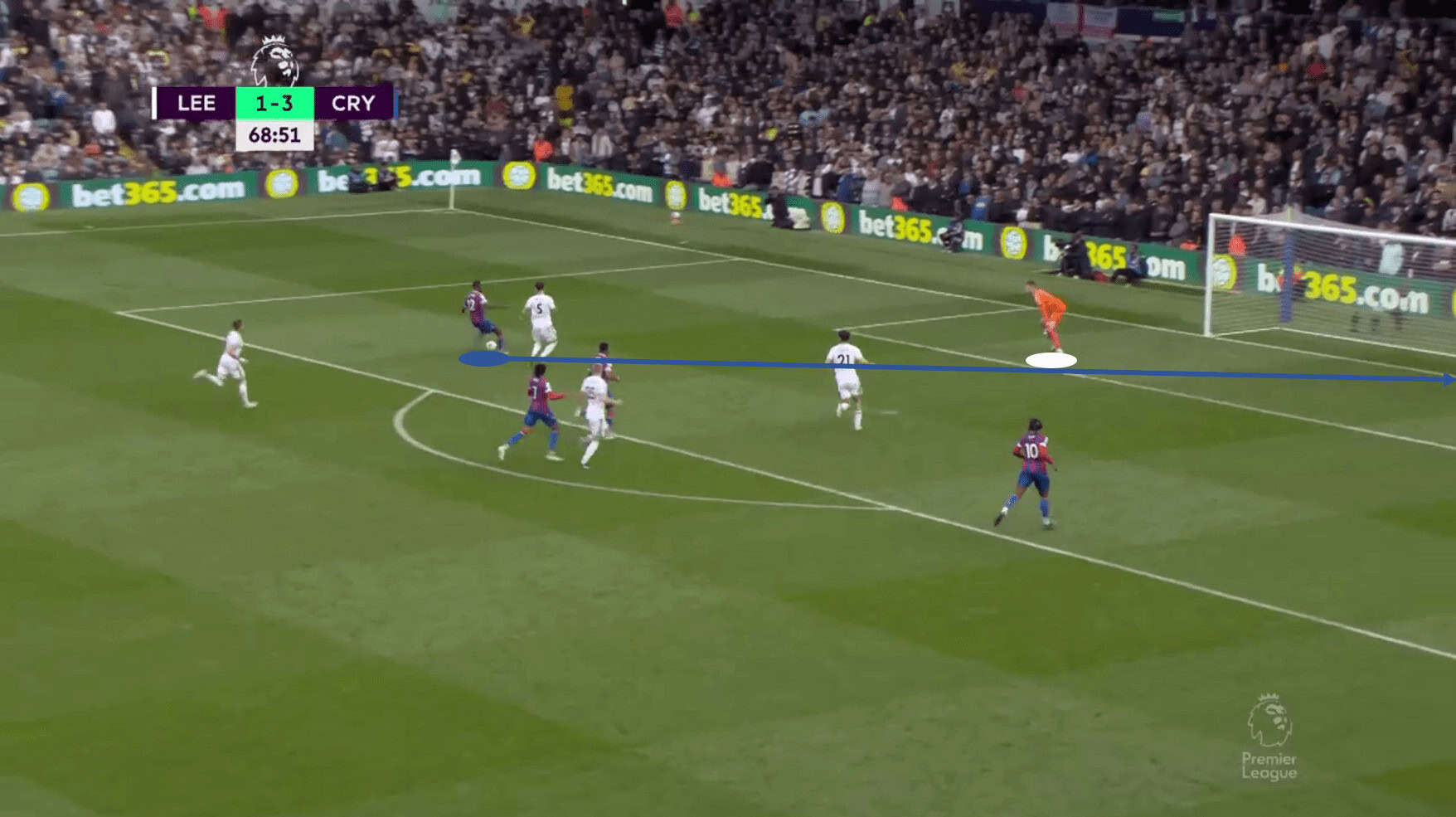
Conclusion
Going back to the top of this article, we are of course basing this on a small sample size of matches where Palace have had a fairly favourable run of fixtures. There is a strong argument to say that the numbers they are putting up aren’t sustainable, and won’t continue once Palace’s fixtures change and they play sides higher up the table. Whilst this may be true, Palace fans won’t care, and nor should they.
When Roy Hodgson returned to the club in March, the message was clear: avoid relegation. Whilst there is uncertainty surrounding the future of Hodgson as Crystal Palace manager going into next season, one thing is certain: Premier League football will be played at Selhurst Park in August.





Comments